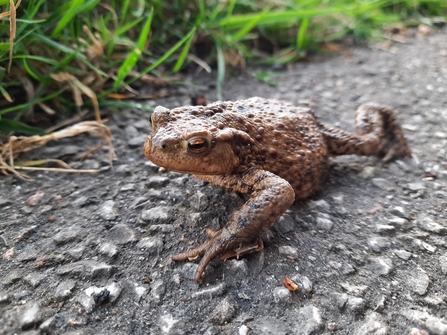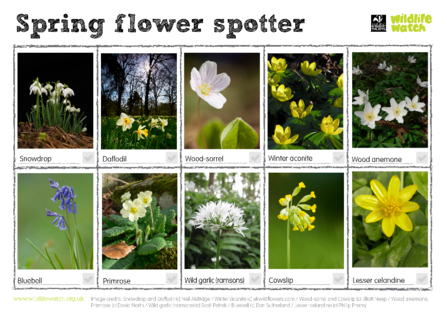
Great spotted woodpecker in woodland. Picture: Mark Hamblin
Violets by Nigel Smith

Great spotted woodpecker in woodland. Picture: Mark Hamblin
Listen out for great spotted woodpeckers drumming on trees this month to announce their presence in the woods!
Did you know their sharp bill is powered by strong neck muscles and their brain is protected from the drumming by a special type of bone that absorbs stress?
You may be lucky enough to have great spotted woodpeckers visiting your bird feeders if you put out peanuts. Take a closer look to work out if your visitor is male or female: male great spotted woodpeckers have red feathers at the nape of their necks while females have no red on their heads at all.
Look out for them at our Bowdown Woods reserve near Newbury.


Grey herons in a nest by Neil Phillips
Grey herons build their large nests in trees by rivers or lakes. You’ll often see many nests in the same tree and these groups of nests are known as heronries.
Male herons put on a courtship dance to attract a female. The male will stretch his long neck upwards and then lower it over his back with the bill pointing upwards.
Grey herons are the most familiar bird in the heron family that you'll see in the UK, but you could also see other heron species including little egret, cattle egret, great white egret and bitterns. Look out for all of them at our Calvert Jubilee nature reserve near Bicester or Weston Turville Reservoir in Bucks.

Great crested grebes (Podiceps cristatus) performing the 'weed dance' courtship ritual. Picture: Andrew Parkinson/ 2020Vision
Great crested grebes also have an elaborate courtship dance. If you're lucky enough to live close to a pond or lake with great crested grebes, watch as the males and females mirror each other on the water, diving down and rising up in perfect unison.
Great crested grebes were once very endangered in the UK. Historically they were hunted for their soft feathers which were used a substitute for fur and elaborate head feathers which were used to decorate women’s hats. Now protected, their numbers have recovered and great crested grebes are once again a relatively common sight. A great place to spot them is our Hosehill Lake reserve near Reading.

A common frog (Rana temporaria) in a pond with spawn. Picture: Luke Massey/ 2020Vision
Frogs breed before toads and you may see great jelly masses of early frog spawn in ponds in February if the temperature rises enough. It may look like a huge amount but very little will survive to become adult frogs. Instead much of it will provide food for predators from garden birds to dragonfly larvae.
Our Greenham Common nature reserve near Newbury is a great place to see all kinds of amphibians.
If you have a pond in your garden, don’t introduce frog spawn from elsewhere, wait until frogs find your pond and create their own.
Build a garden pond (https://youtu.be/NPwEvxYhfSg)
Create a wildlife pond

A common toad (Bufo bufo). Picture: Pete Hughes
Toads breed later in the spring than frogs but this month you should see them start to return to their breeding areas. Some toads have to cross roads to reach the ponds. You can help them cross safely by becoming a toad patroller.
It's easy to tell toad spawn and frog spawn apart if you have both in your pond: toad spawn is made up of long, linear strands of eggs, while frog spawn is made up of large clumps.

Hazel catkins. Photo by Philip Precey
Hazel produces female flowers and male catkins at this time of year. The tiny flowers are bright pink. Take a close look and be amazed by this minute flower waiting to catch pollen released by the catkins.
The catkins hang like little (lamb’s!) tails from bare branches, wafting pollen in the breeze.
Hazel isn’t the only plant that produces catkins but is one of the earliest. Other trees that produce catkins include willow species, birch and alder.

A willow catkin at BBOWT's Warburg Nature Reserve. Picture: Pete Hughes
Goat willow, or pussy willow, is a small willow tree found in ditches, reedbeds and wet woodland, and on urban waste ground. It is one of the UK's commonest willows and is known for the fluffy, silver-grey, male catkins - or 'pussy willows' - that appear in January and turn bright yellow in March. The female catkins are greenish. Both male and female catkins are an important winter food source for insects.
The goat willow has many common names, including 'Great Sallow', 'Sally' and 'Black Sally'; the name 'Palm willow' refers to its use as a decoration in churches during Easter.
We took the picture above at our Warburg Nature Reserve near Henley in South Oxfordshire.

A lesser celandine flower growing on a roadside verge in West Berkshire. Picture: Simon Claybourn
Look for a sunny splash of colour from lesser celandines. They have shiny, heart-shaped leaves and flower in early spring. You might spot them in damp woodland or along stream banks and ditches. They're an important source of food for early insects emerging after winter.


Violets by Nigel Smith
Sweet violet (Viola odorata) is the first of the violets of the year to bloom. This is the only violet which has a fragrance so take a sniff if you see one!
Later in spring look for common dog-violet in woods and hedge-banks. Hairy violet grows in grassland and scrubby areas on lime and chalk.
Look out for violets at our Dancersend reserve in Buckinghamshire, Bowdown Woods near Newbury and Rushbeds Wood near Bicester.

Wood Mouse by Jon Hawkins Surrey Hills Photography
The tiny, brown wood mouse is one of our commonest rodents and is very likely to be found in the garden - but it is nocturnal. Similar to the house mouse, it has larger ears and eyes relative to its size.
Wood mice gather food stores of berries and seeds in the autumn, which they keep in underground burrows or sometimes in old birds' nests over winter. February is the time of year when they start to breed again, so you are more likely to spot them out and about. Females have up to six litters a year, each with between four and eight young.
Sign up below to receive the latest news from BBOWT, tips about how you can help wildlife, plus information on how you can get involved.